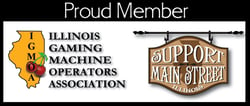When getting your business off the ground, or rebranding your current establishment, logo creation should be one of the first things considered. Your establishment’s logo acts as the face of your brand. It is the first impression customers have even before stepping foot inside your location. Creating a logo for your business doesn’t have to be a daunting task. All that’s needed to get started is a little research and some careful thought about what you want your location’s brand to convey.
The first step for creating a logo for your business is doing research on your industry. What do the logos of your competitors convey to the customer? What about a larger business that you look up to? Look for things that you enjoy as a business owner and as a customer. Then identify things that you don’t like stylistically. Keep these things in mind when it comes time to creating your own logo. It is always a great idea to look at those in the industry for inspiration and to help you decide how you want to differentiate from your competition. However, don’t go as far as to copy or take someone else’s designs. This will only hurt your business’ reputation and credibility.
Types of Design
There are four main types of logos to choose from. However, the best options for a business owner getting started would be to choose either wordmark, iconic or combination mark. Each of these types of logos have their own benefits and shortcomings.
Wordmarks use the company’s name, but in a unique design or custom-font (Think: Google, Coca-Cola, Visa). A wordmark is a good decision if you’re a new business trying to get your name out there. When designing a wordmark logo, ensure that your business’s name is short enough to take advantage of the design elements. A name that is too long can look cluttered and turn customers off to the business.
Pictorial marks use simple graphics or symbols that can have a literal or abstract association to what the business does (Examples include: Apple, Twitter, Target). This type of logo can help create an iconic feel to a business and be easily transferred from social media to an outdoor sign to a business card without having to redesign. However, this kind of logo can be tricky for a new business that doesn’t have strong brand recognition.
Combination marks incorporate both text and graphic, often allowing the two to be combined or separate (Think: Doritos, Burger King, Adidas). A combination mark is a great choice for virtually any type of business. Oftentimes companies have a logo and a tagline, these companies will often have a logo that combines the two. This is a sign of a good logo.
Steps to Creation
After doing some industry research on identifying what you like and what you don’t like for your business, it is time to get started with designing your logo.
- Before working on any design elements, start with a font. Type out the name of your business and play around with fonts. What best reflects your business and the industry as a whole? Once you settle on a font, stick with it throughout the design process.
- Chose 2-3 colors that go well with your industry
- Example: A bar, restaurant or gaming café would have bold and eye-catching colors like navy, dark green or crimson. However, a non-traditional location like a laundromat or flower shop might have more muted colors like light blues or yellows.
- Once you begin designing, try many different designs with a similar theme. Ask trusted friends, family or colleagues for their feedback to help narrow it down. When the design has been narrowed down, make sure it looks good in black and white as well as in color.
- Create one main graphic without the name of the establishment that can be used in a variety of different mediums. Think of this as a sticker for your business. Creating this ahead of time will save you a headache later in case you might need the standalone logo for a different purpose. For example, Accel Entertainment’s logo is easily established with the AE and does not necessarily need to include “Accel Entertainment” with it.
Design Support
There are many different platforms out there that can help small business owners get started on creating a logo. These are three sites that might be beneficial, but don’t let this limit you!
Any graphic designer would probably tell you to start with Adobe Illustrator for logo design. This will offer you the most freedom and options to create a beautiful and thoughtfully designed logo for your business to use. Using Adobe Illustrator is a bit more involved to use than some other tools, but don’t let that discourage you. There are tons of helpful video and article tutorials online, we found some to get you started.
If you’ve created a website for your business, you probably came across the platform Wix. Wix recently rolled out a Logo Maker for business owners to use for free. They claim to have put together all the tools you need to design your own logo, along with a guide to help you choose the right colors, fonts and best practices.
Canva is a platform often hailed for their easy to use drag and drop design elements. Canva also has a specific section for logo making that they say is created for “non-designers.”
Remember...
When creating a logo for your business, keeping the design simple will make the process much better and faster in the long run. It might seem like a daunting task to design a logo, but it is a critical part of the branding of your business.
Sources:
https://www.huffingtonpost.com/casey-cavanagh/post_10018_b_8042526.html
https://99designs.com/blog/tips/types-of-logos/
https://justcreative.com/2017/06/28/logo-design-tips-for-small-business-owners/




_121_Full%20Color_ON%20BLACK-01.png?width=267&name=AE_MultiLogo(H)_121_Full%20Color_ON%20BLACK-01.png)
